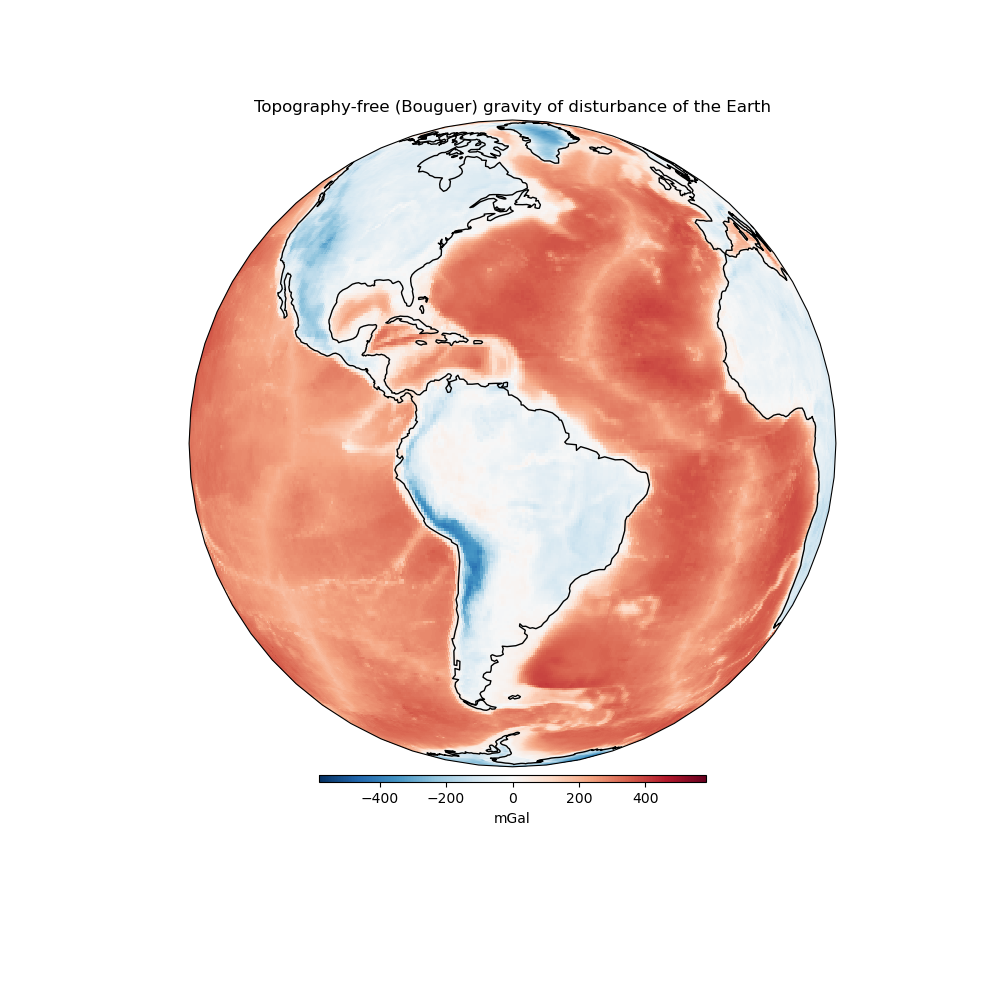Topography-free (Bouguer) Gravity Disturbances
Note
Click here to download the full example code
Topography-free (Bouguer) Gravity Disturbances¶
The gravity disturbance is the observed gravity minus the normal gravity
(boule.Ellipsoid.normal_gravity). The signal that is left is assumed to
be due to the differences between the actual Earth and the reference ellipsoid.
Big components in this signal are the effects of topographic masses outside of
the ellipsoid and residual effects of the oceans (we removed ellipsoid crust
where there was actually ocean water). These two components are relatively well
known and can be removed from the gravity disturbance. The simplest way of
calculating the effects of topography and oceans is through the Bouguer plate
approximation.
We’ll use harmonica.bouguer_correction to calculate a topography-free
gravity disturbance for Earth using our sample gravity and topography data. One
thing to note is that the ETOPO1 topography is referenced to the geoid, not the
ellipsoid. Since we want to remove the masses between the surface of the Earth
and ellipsoid, we need to add the geoid height to the topography before Bouguer
correction.

Out:
<xarray.Dataset>
Dimensions: (latitude: 361, longitude: 721)
Coordinates:
* longitude (longitude) float64 -180.0 -179.5 -179.0 ... 179.5 180.0
* latitude (latitude) float64 -90.0 -89.5 -89.0 ... 89.0 89.5 90.0
Data variables:
gravity (latitude, longitude) float64 9.801e+05 ... 9.802e+05
height_over_ell (latitude, longitude) float64 1e+04 1e+04 ... 1e+04 1e+04
geoid (latitude, longitude) float64 -29.5 -29.5 ... 15.37 15.37
topography (latitude, longitude) float64 2.762e+03 ... -4.179e+03
Attributes: (12/35)
generating_institute: gfz-potsdam
generating_date: 2018/11/07
product_type: gravity_field
body: earth
modelname: EIGEN-6C4
max_used_degree: 1277
... ...
maxvalue: 9.8018358E+05 mgal
minvalue: 9.7476403E+05 mgal
signal_wrms: 1.5467865E+03 mgal
grid_format: long_lat_value
attributes: longitude latitude gravity_ell
attributes_units: deg. deg. mgal
import boule as bl
import cartopy.crs as ccrs
import matplotlib.pyplot as plt
import xarray as xr
import harmonica as hm
# Load the global gravity, topography, and geoid grids
data = xr.merge(
[
hm.datasets.fetch_gravity_earth(),
hm.datasets.fetch_geoid_earth(),
hm.datasets.fetch_topography_earth(),
]
)
print(data)
# Calculate normal gravity and the disturbance
ellipsoid = bl.WGS84
gamma = ellipsoid.normal_gravity(data.latitude, data.height_over_ell)
disturbance = data.gravity - gamma
# Reference the topography to the ellipsoid
topography_ell = data.topography + data.geoid
# Calculate the Bouguer planar correction and the topography-free disturbance.
# Use the default densities for the crust and ocean water.
bouguer = hm.bouguer_correction(topography_ell)
disturbance_topofree = disturbance - bouguer
# Make a plot of data using Cartopy
plt.figure(figsize=(10, 10))
ax = plt.axes(projection=ccrs.Orthographic(central_longitude=-60))
pc = disturbance_topofree.plot.pcolormesh(
ax=ax, transform=ccrs.PlateCarree(), add_colorbar=False
)
plt.colorbar(
pc, label="mGal", orientation="horizontal", aspect=50, pad=0.01, shrink=0.5
)
ax.set_title("Topography-free (Bouguer) gravity of disturbance of the Earth")
ax.coastlines()
plt.show()
Total running time of the script: ( 0 minutes 2.309 seconds)
